Chiseldon cauldrons
Unearthing and conserving an Iron Age feast
Source -http://www.britishmuseum.org/research/research_projects/featured_project_chiseldon.aspx

In 2004 a large group of Iron Age cauldrons was discovered at a site near Chiseldon in the United Kingdom. It was a unique find; the largest group of Iron Age cauldrons ever to be discovered in Europe. Their study will significantly contribute to the understanding of these important artefacts.
The group of 12 or more cauldrons provide a chance to research their manufacture, use and burial. This will help re-assess the chronology and social importance of cauldrons, as well as related sheet-metal vessels, in Iron Age Britain and Ireland in a wider European context.
Excavation
The vessels were too large to be easily removed and there was still insufficient evidence for experts to identify and date the cauldrons so the find remained a puzzle. Analysis of a fragment of the vessel at Oxford University demonstrated that the object was probably prehistoric. This discovery was unexpected and in 2005 a small ‘rescue excavation’ by a team of specialists from the British Museum, the Portable Antiquities Scheme and Wessex Archaeology was organised.
These excavations found a minimum of 12 fragmentary Iron Age metal cauldrons deliberately buried together in a pit with two cow skulls. The cauldrons were stacked or placed in the pit whole and roughly half were upside down. The others were either the right way up or on their sides.
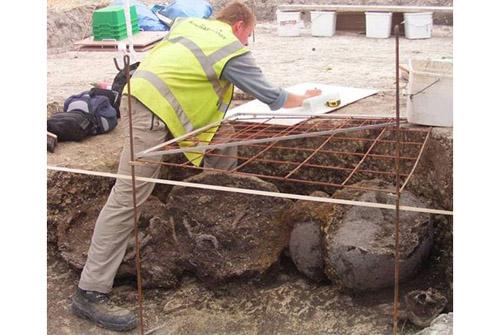
A small quantity of pottery was also discovered and dated to the Early or Middle Iron Age (800-100 BC), further confirming the dating suggested by metal analysis
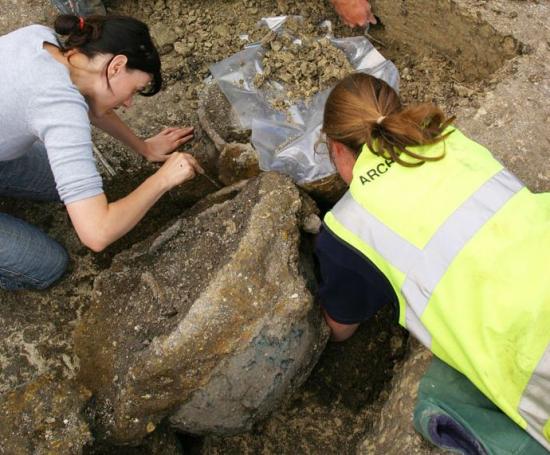 .
.
To ensure the objects were disturbed as little as possible, the cauldrons were lifted complete in soil blocks by British Museum conservators.
Further study
The cauldrons were acquired by the British Museum in May 2007 and remain in their lifted state. They are globular in shape and vary in size between approximately 60 and 80 cm wide at the rim. They are made from bands of iron and sheet copper-alloy with iron handles.
In 2008 one of the cauldrons was micro-excavated from the block of soil in which it was encased in the conservation lab at the British Museum.
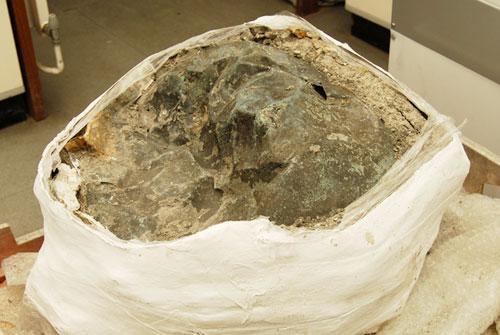
The bowl of the excavated cauldron is formed of a single sheet of copper-alloy, less than one millimetre thick, hammered to shape. The depth is estimated at 34 cm.
The joins between the bands are secured using rivets and residue found between these joins could be some kind of resin used to make the them watertight. Soot on the bottom of the cauldron indicates that it was used before being put in the ground but it is difficult to determine how long it was used for or the intensity of usage. Possible evidence for repair, particularly on the iron rim may indicate that it was used for a period of time before it was deposited and suggests it was not manufactured especially for burial.
Conserving the Chiseldon cauldrons
Conservation of one cauldron from Chiseldon has already taken place. It was micro-excavated from its soil block in the conservation lab at the British Museum. The plaster bandages and clingfilm barrier layer used to support the fragile object during lifting and transprt wre gradually cut away. Soil was removed from around the object in layers using small dental tools and scalpels. Each stage of the process was carefully recorded with photographs and drawings. The position of any detached fragments of metal or analytical sample was noted and then removed.
The cauldron had been buried upside down and was crushed due to the weight of overlying soil, pushing the base into the rim. It was in a worse condition than was initially thought, with the base and rim sections completely separate.
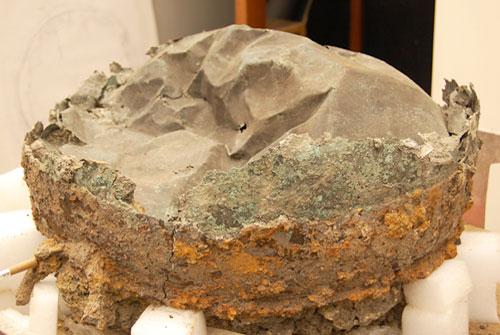
Access to the inside of the cauldron was necessary to remove soil deposits, but it could not be turned the right way up due to the fragility of the heavily corroded metal. Instead the sides of the cauldron were removed from the block in sections using existing cracks caused during burial.
A fibre glass and resin support was made for each section to cradle it during removal and cleaning. The interior of the cauldron was cleaned to remove the soil and small areas of repair and backng carried out to strengthen the metal.
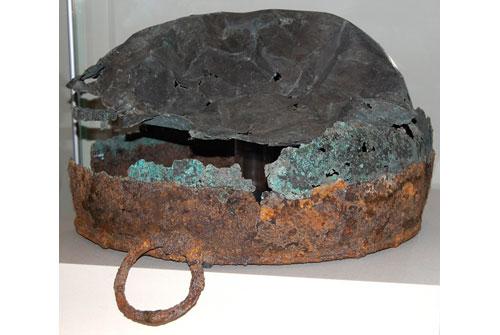
The rim sections were then reassembled, although the rim and base remain separate as metal joining the two had corroded away during burial. A mount was made to support the base of the cauldron in its correct position.
Over the next two years each cauldron will be carefully conserved in turn. Technological details uncovered during conservation, and samples collected for analysis (including mineralised plant remains, bone, charcoal and possible food residues), will reveal information about how each cauldron was constructed and used.
VIDEO = http://www.britishmuseum.org/about_this_site/audio_and_video/conservation_and_science/chiseldon_cauldron.aspx
PART. 2